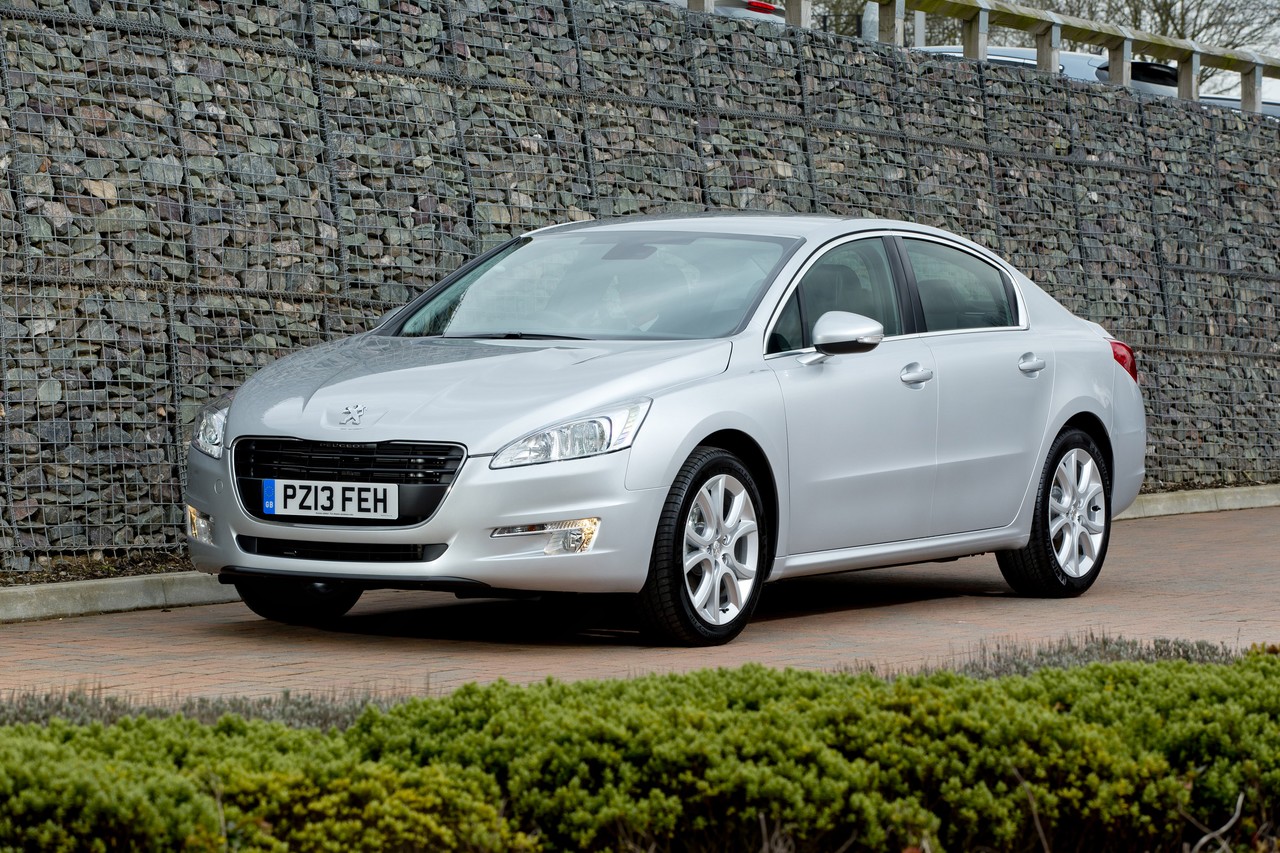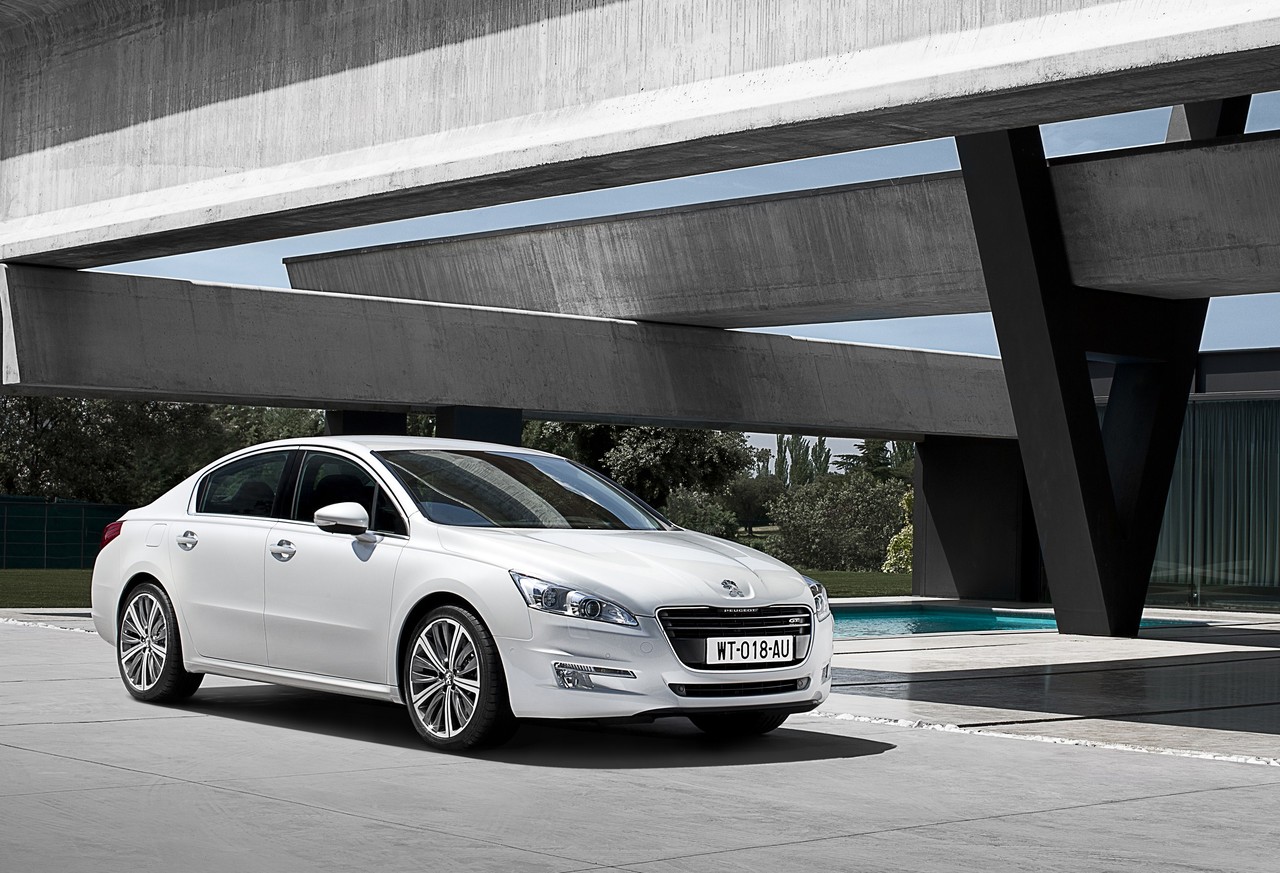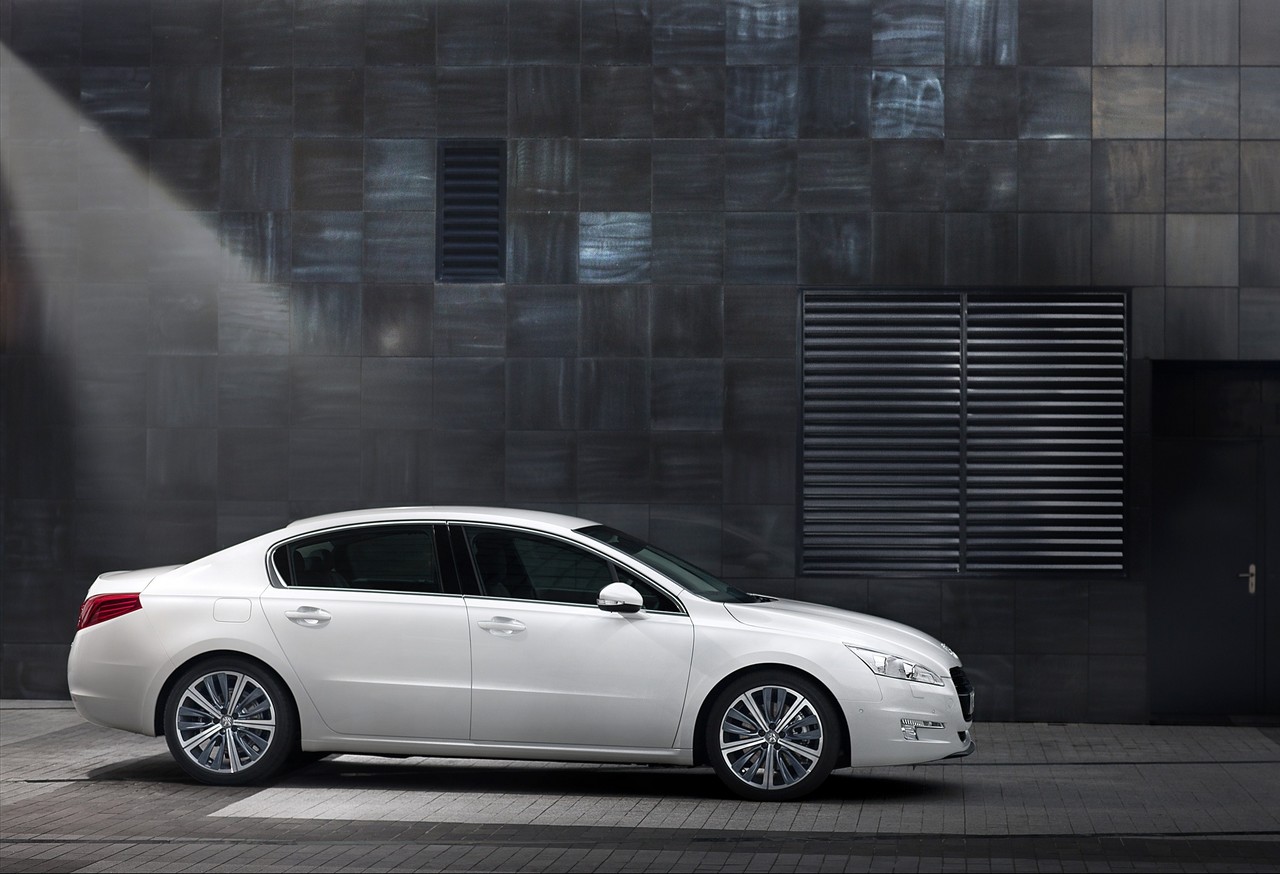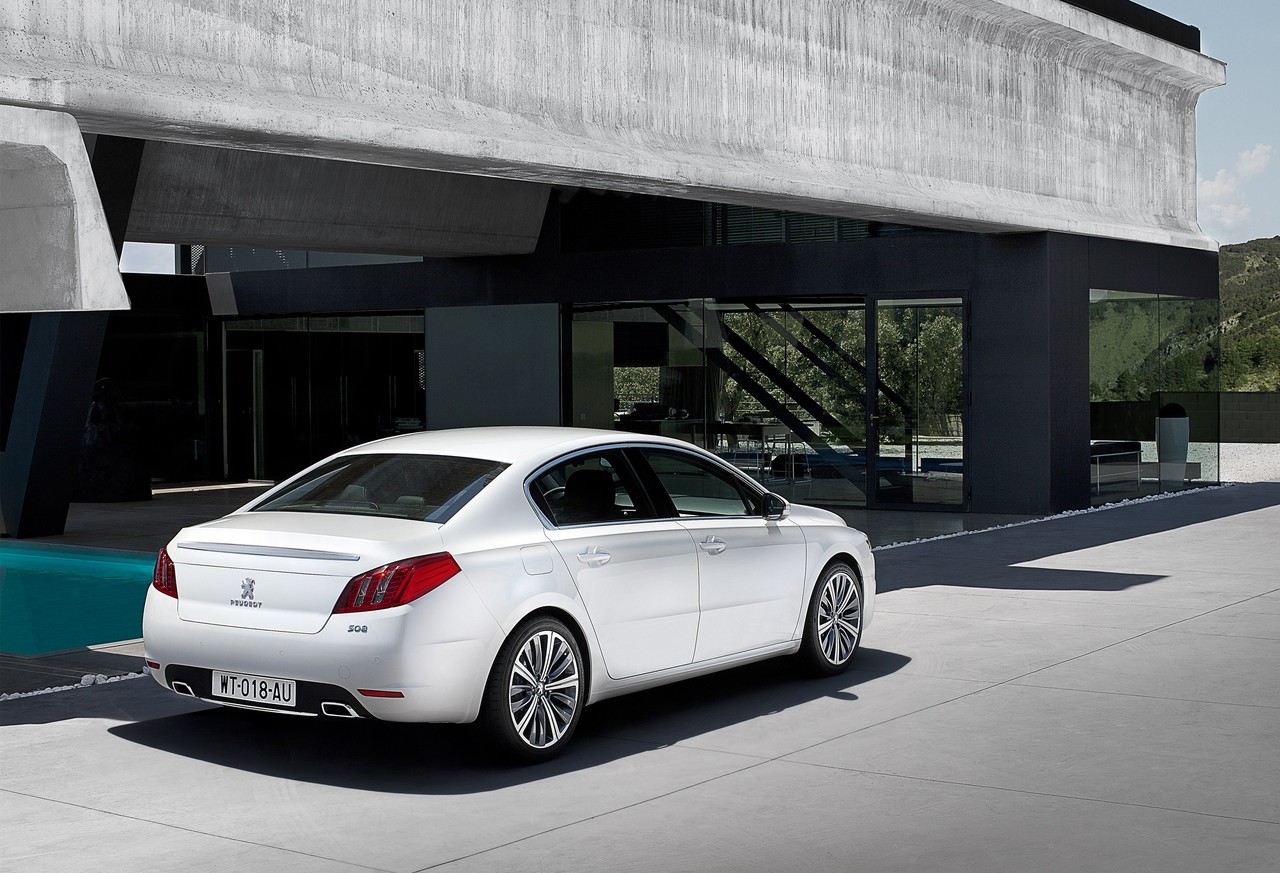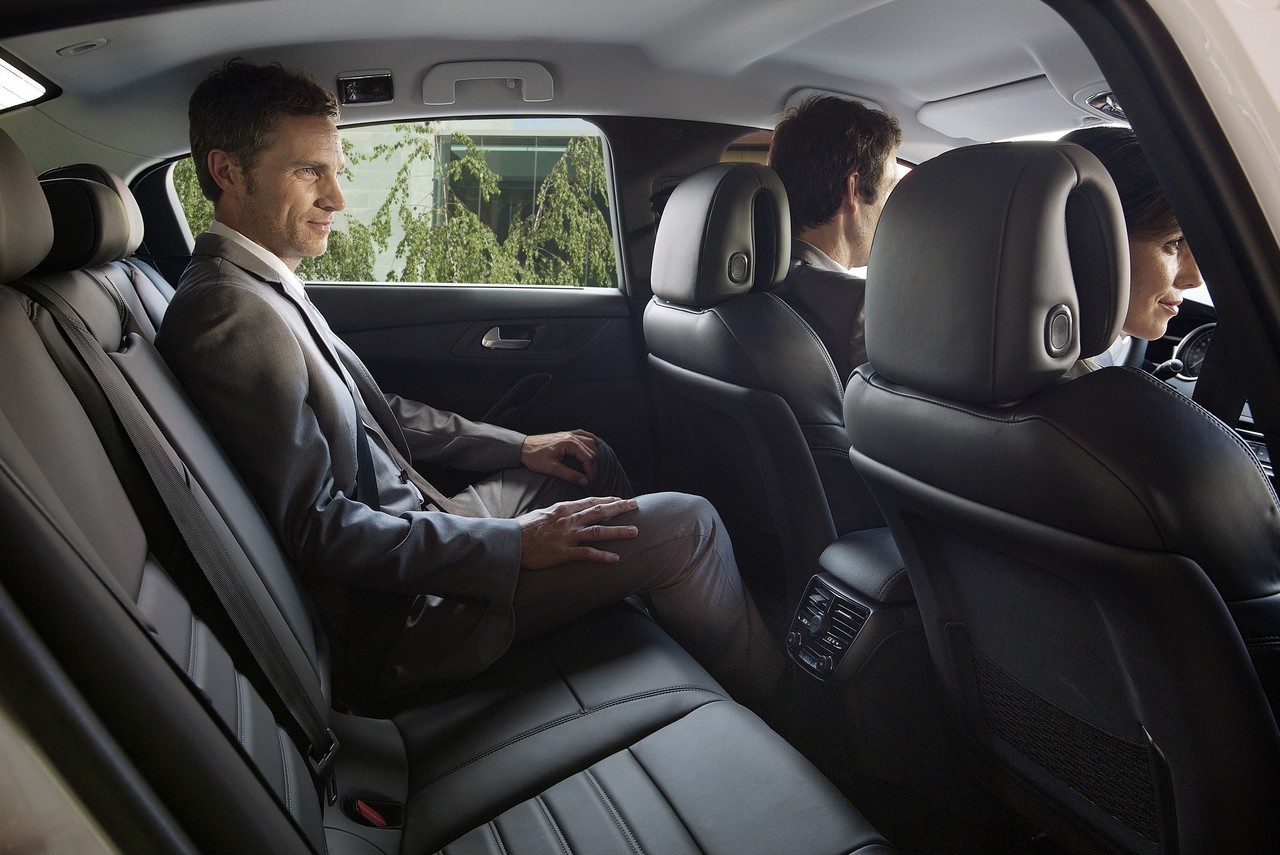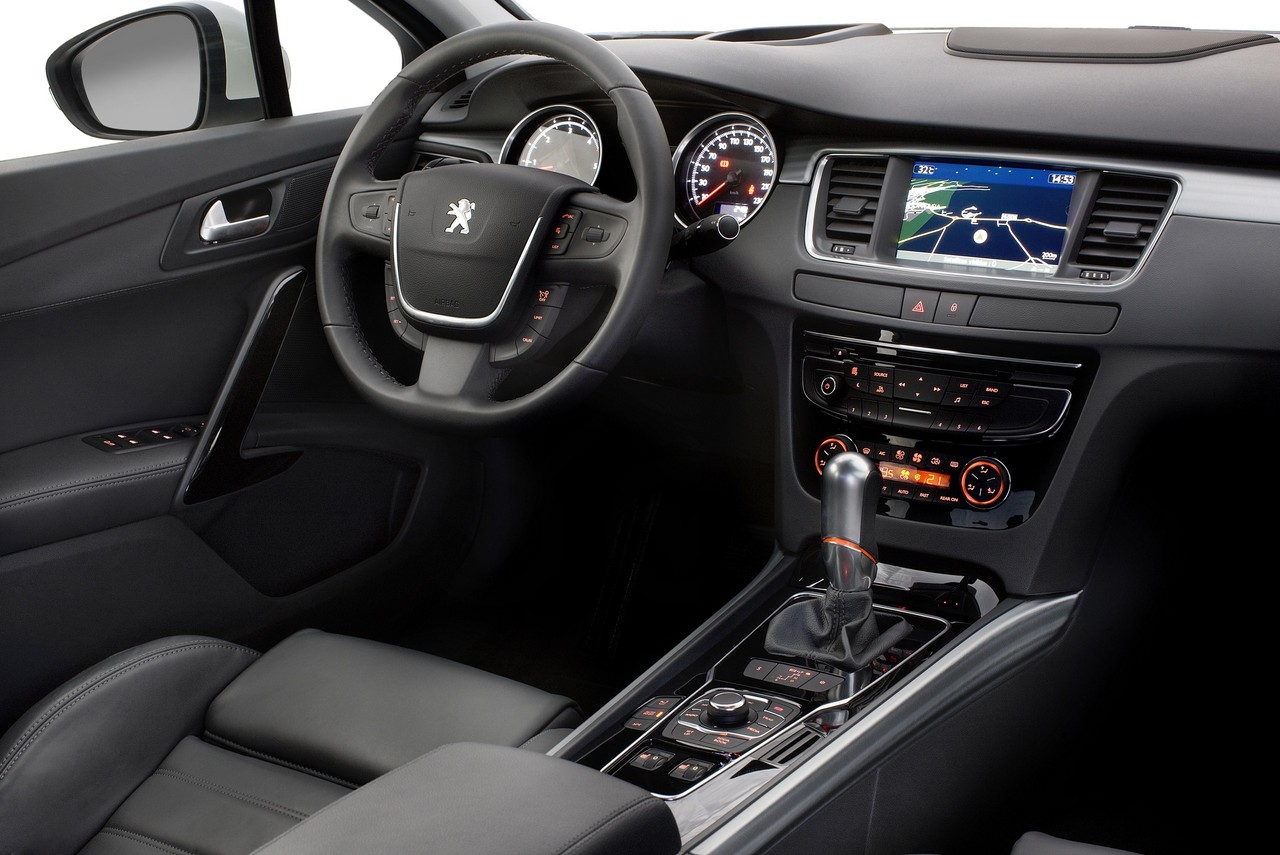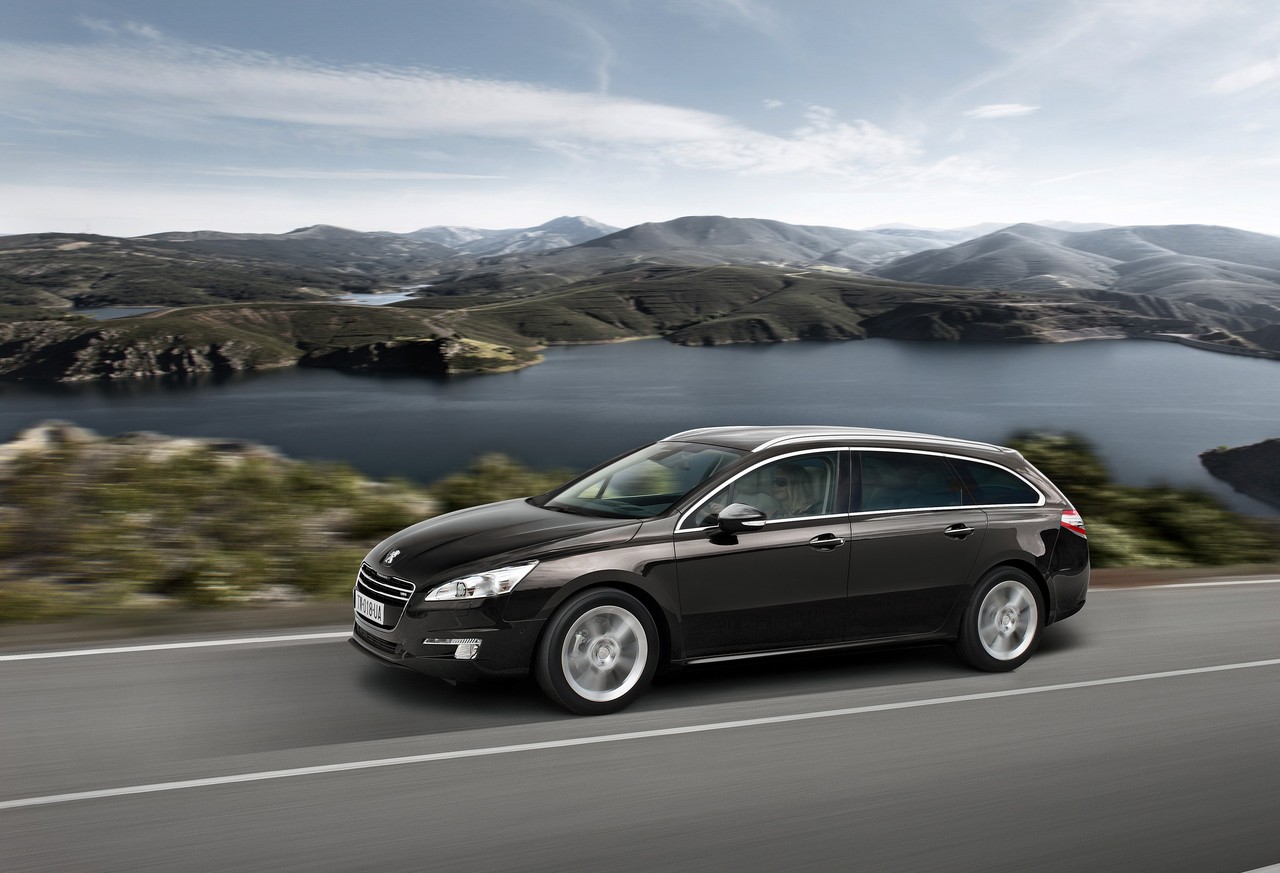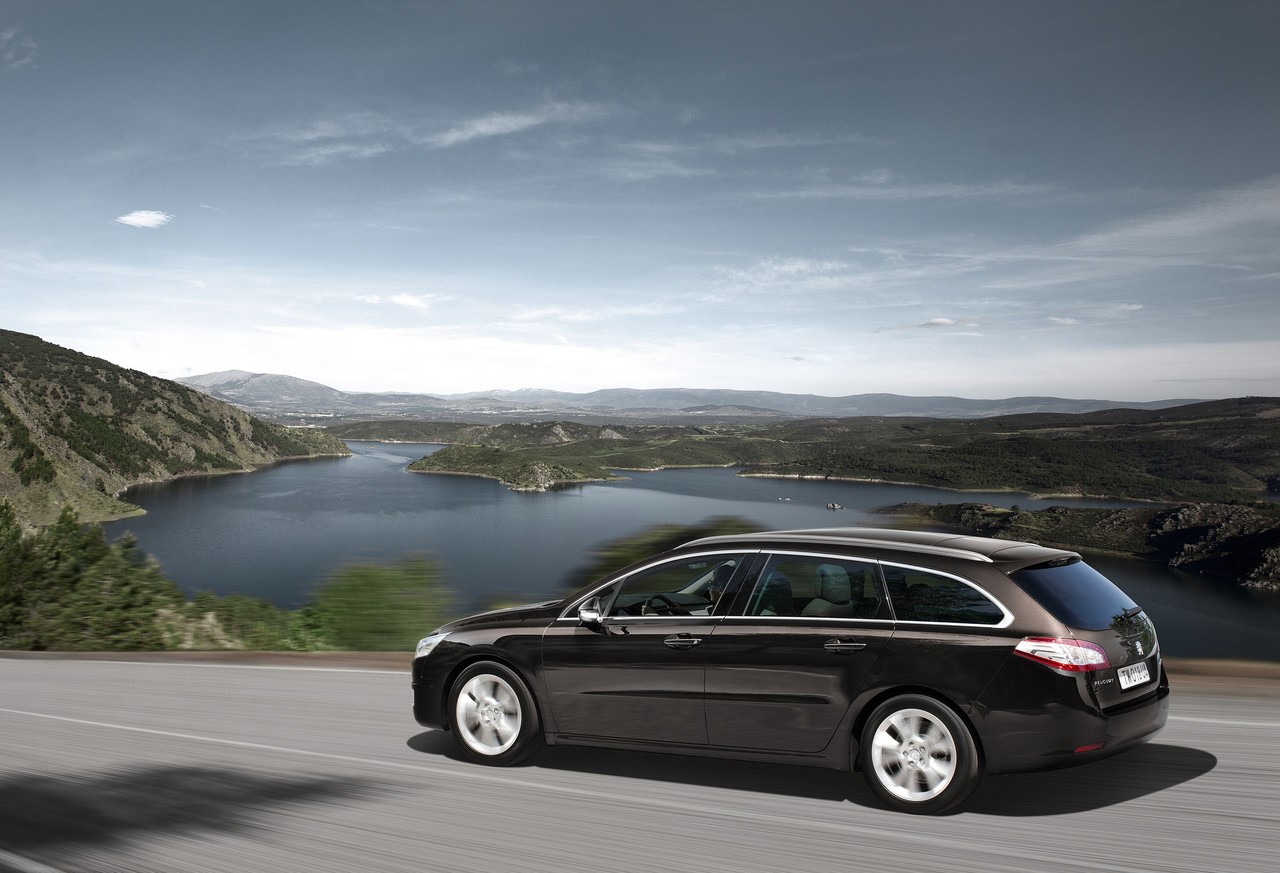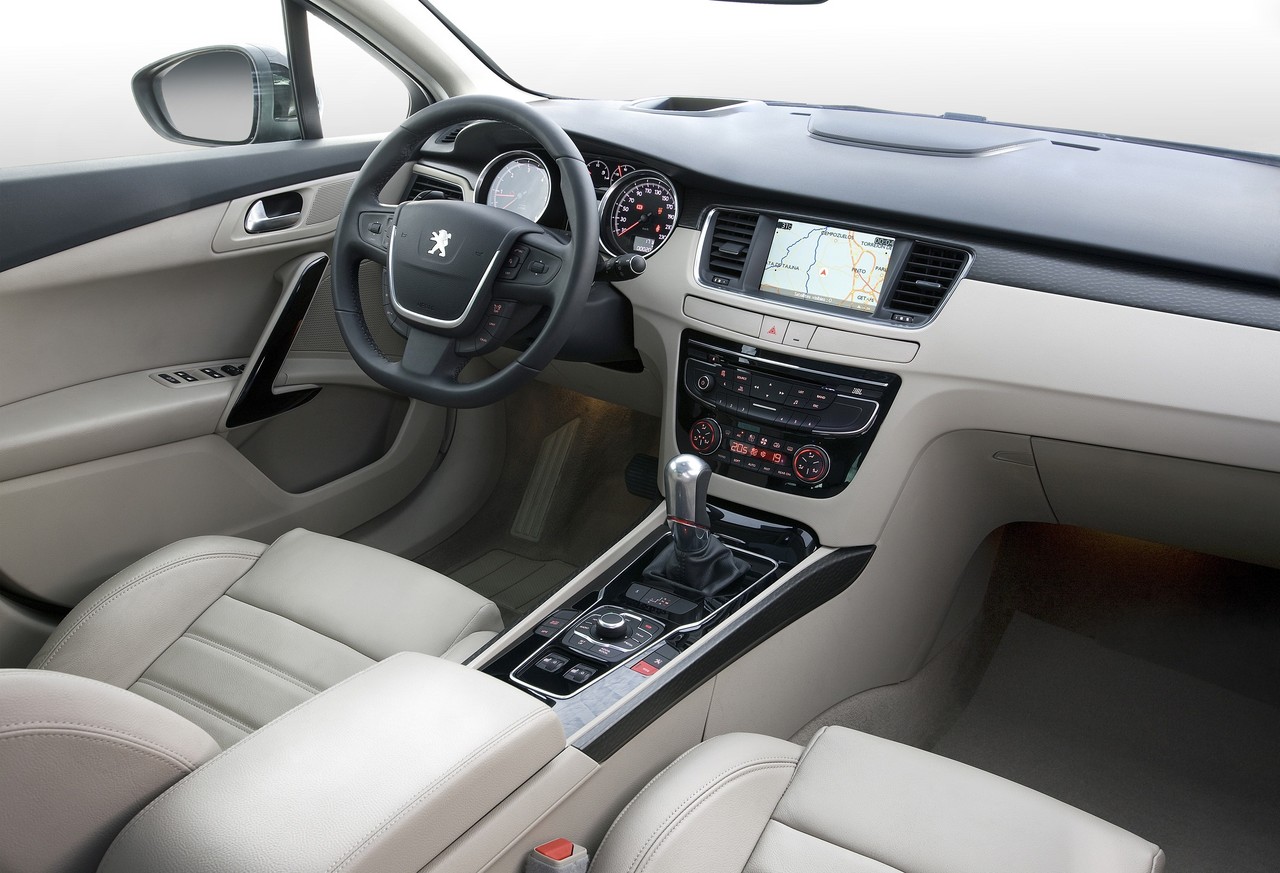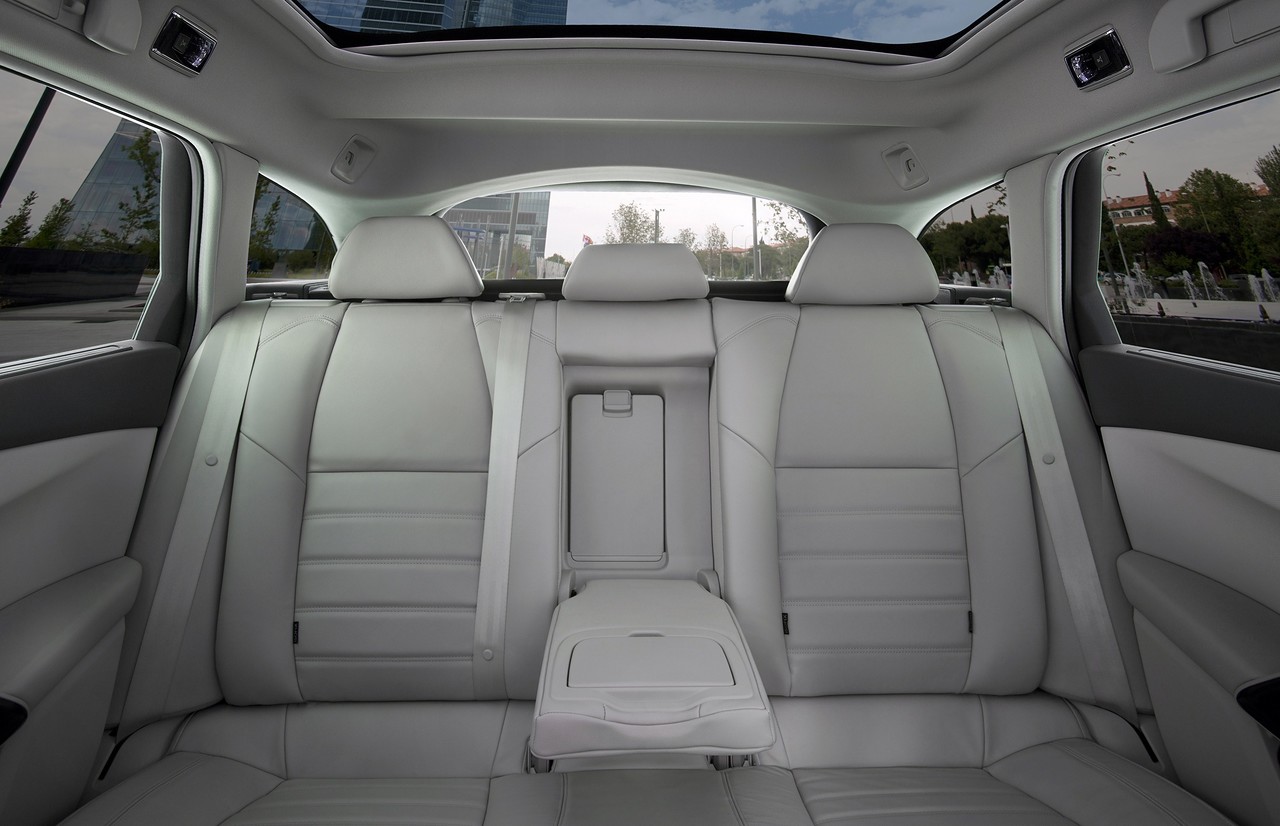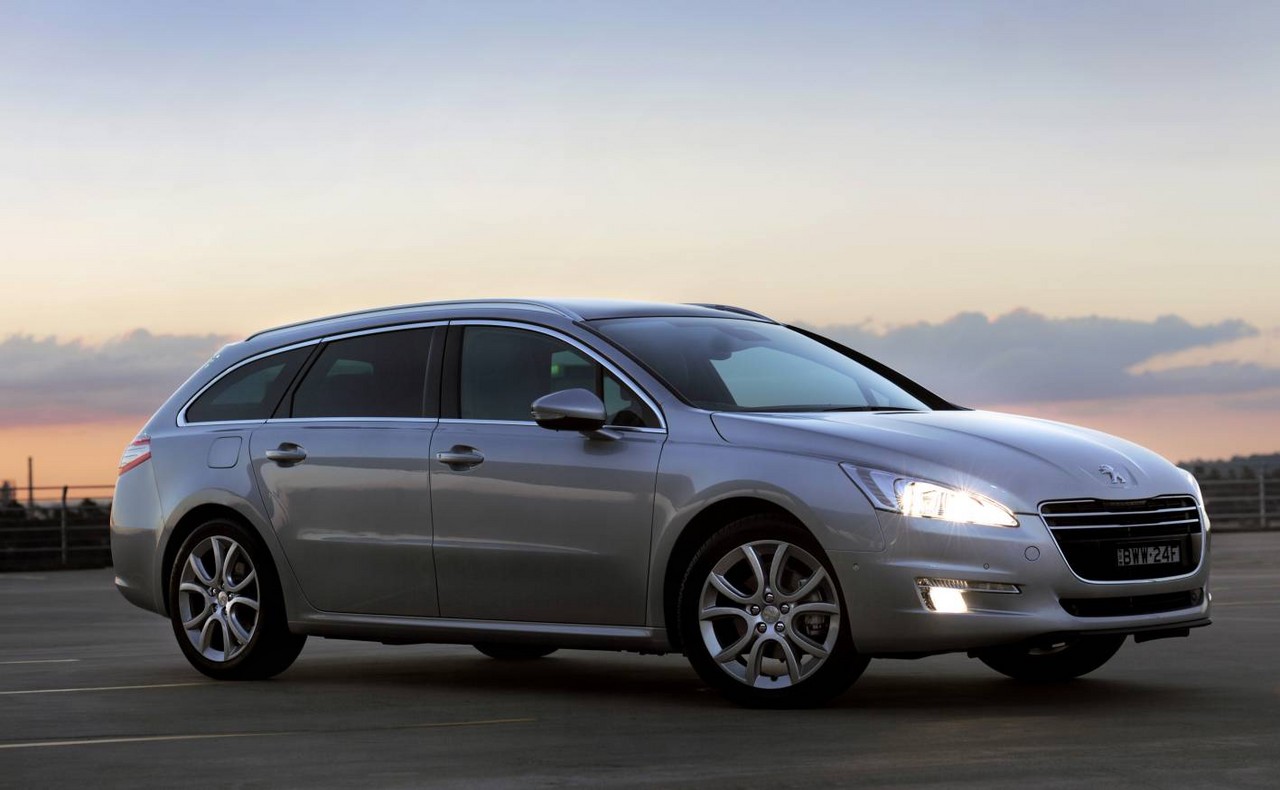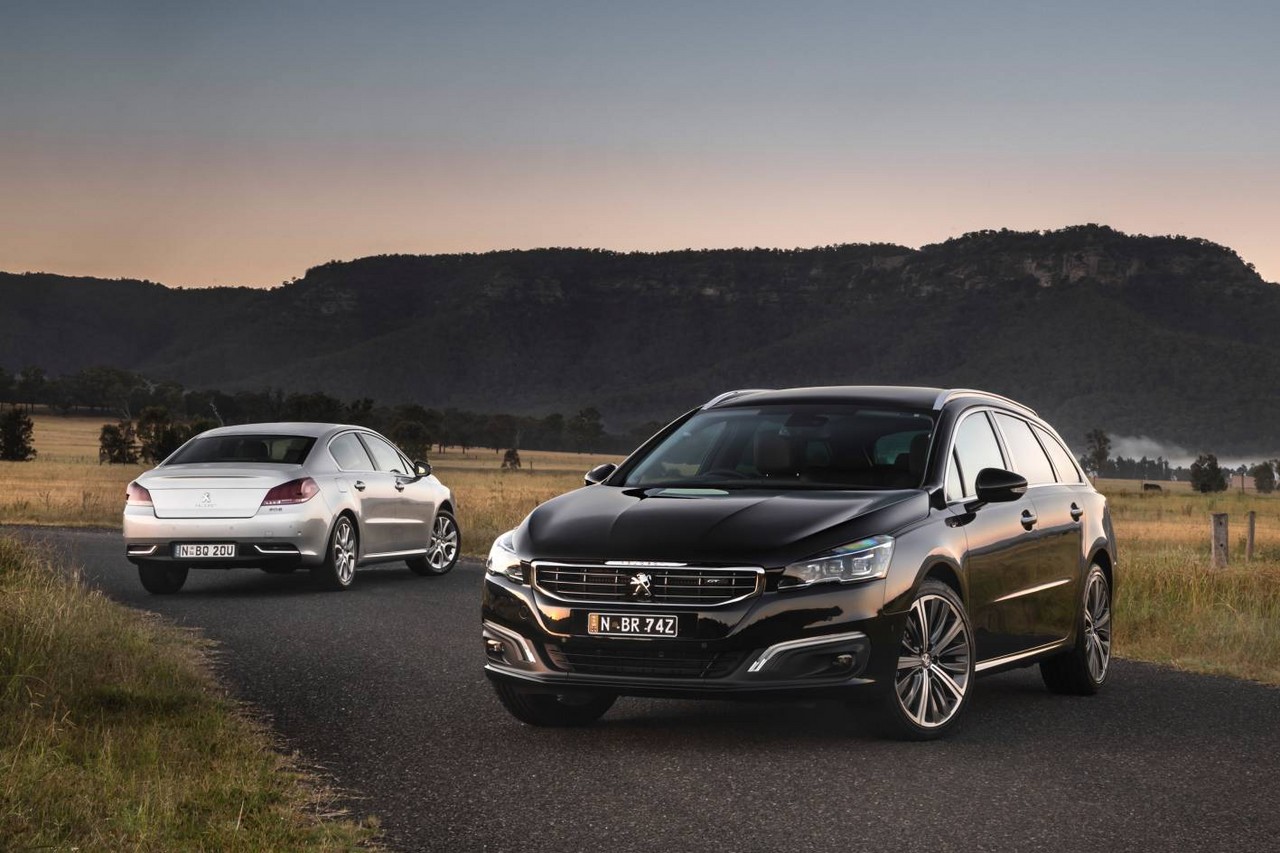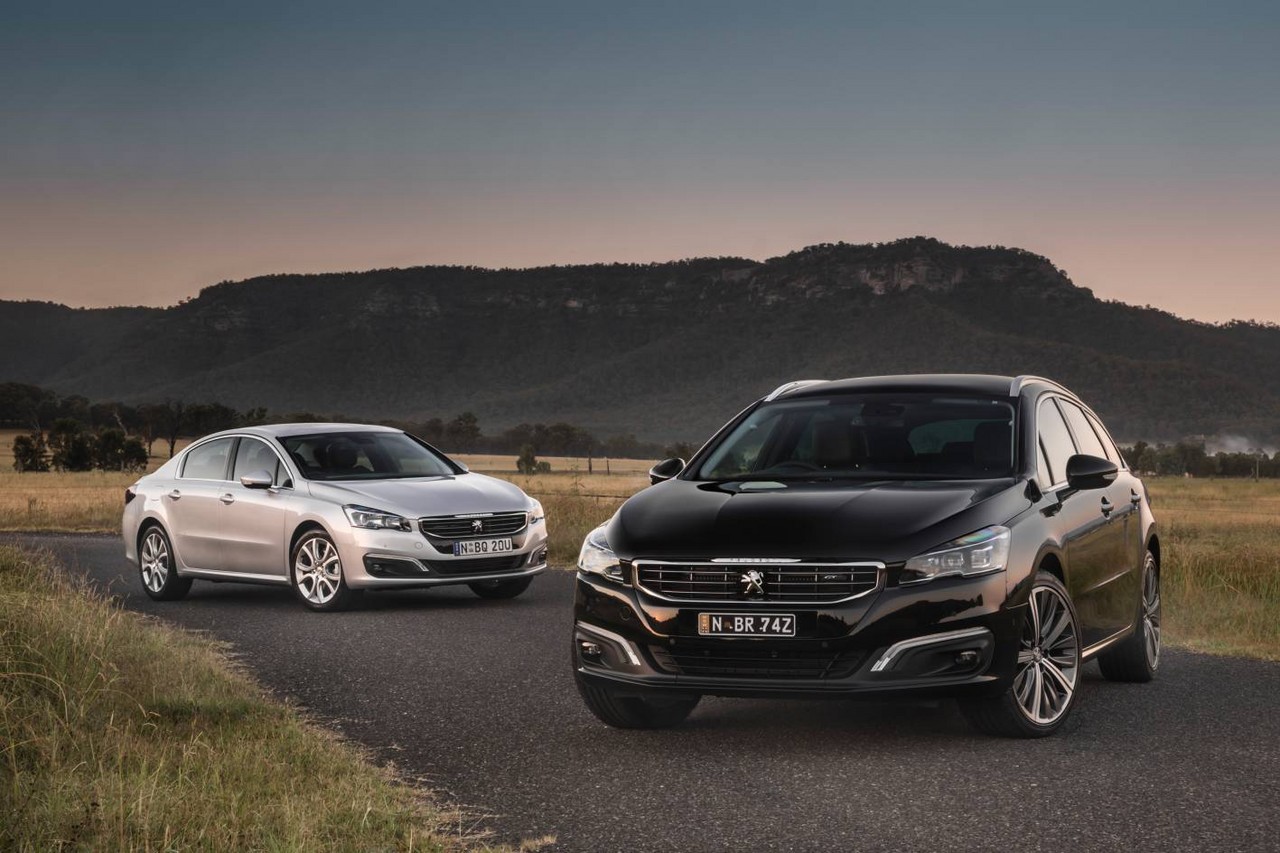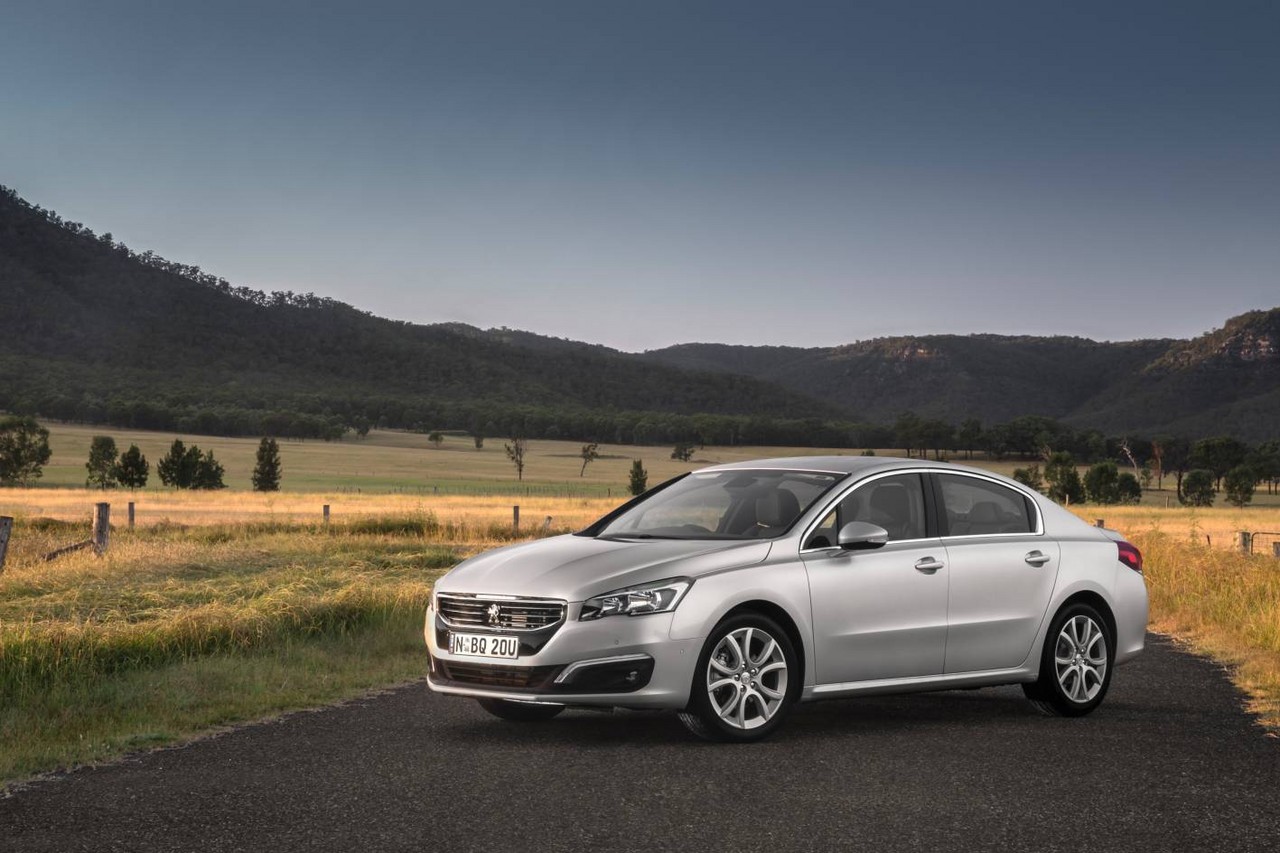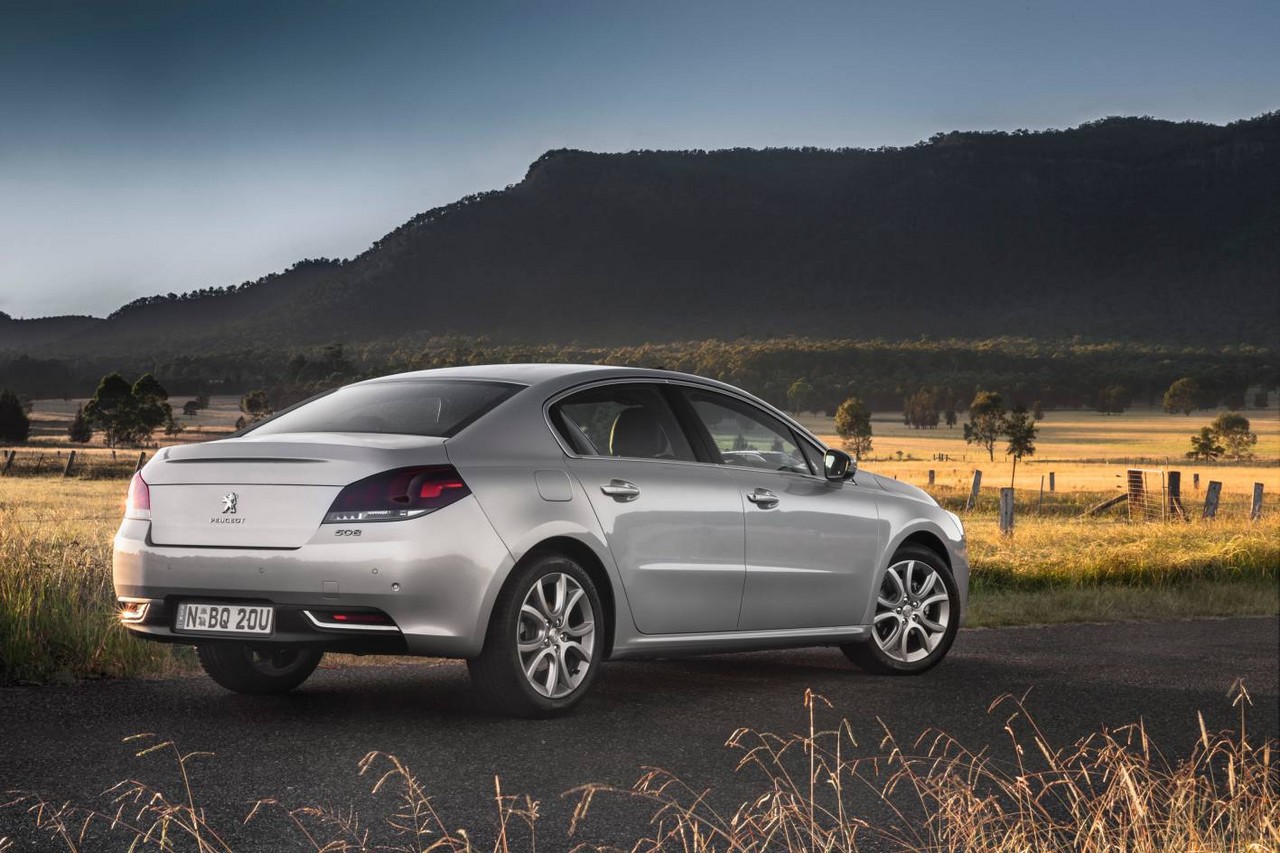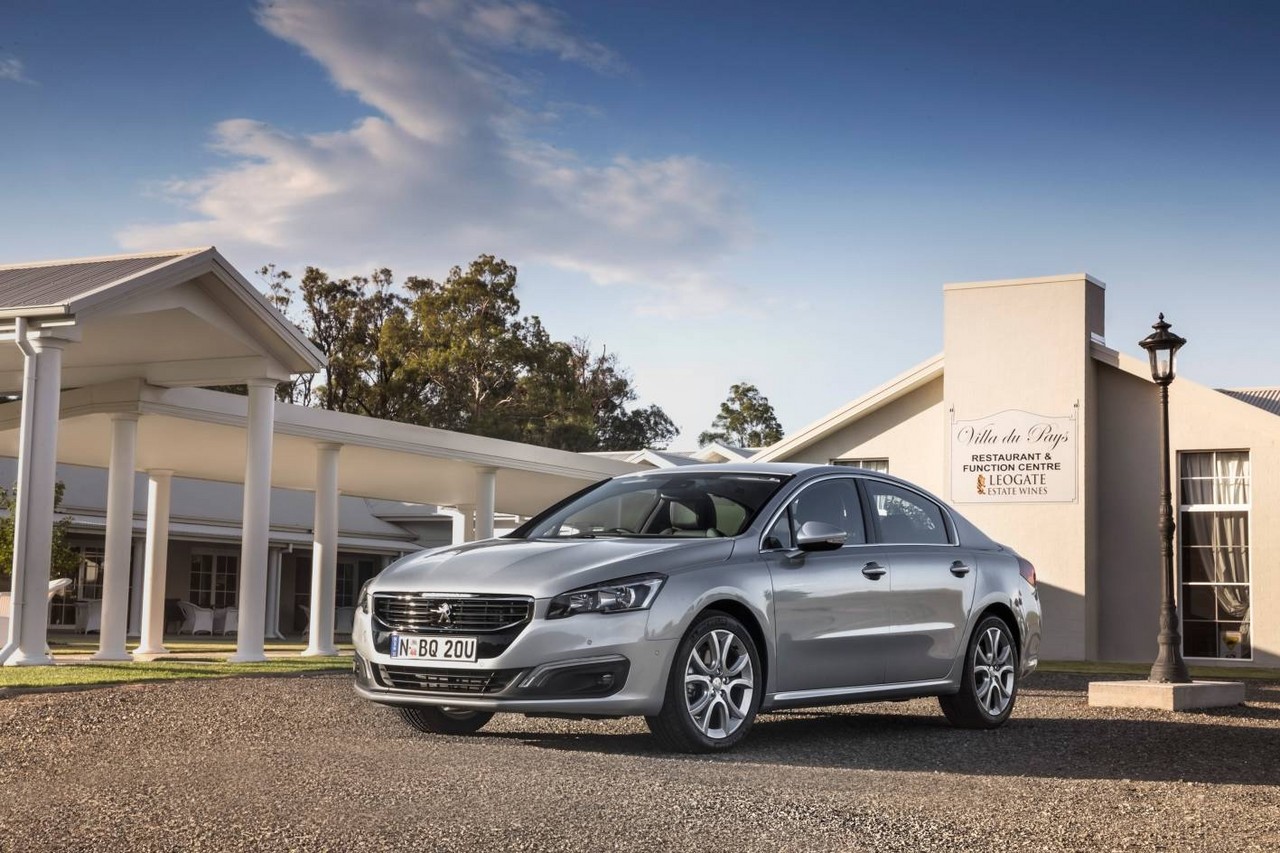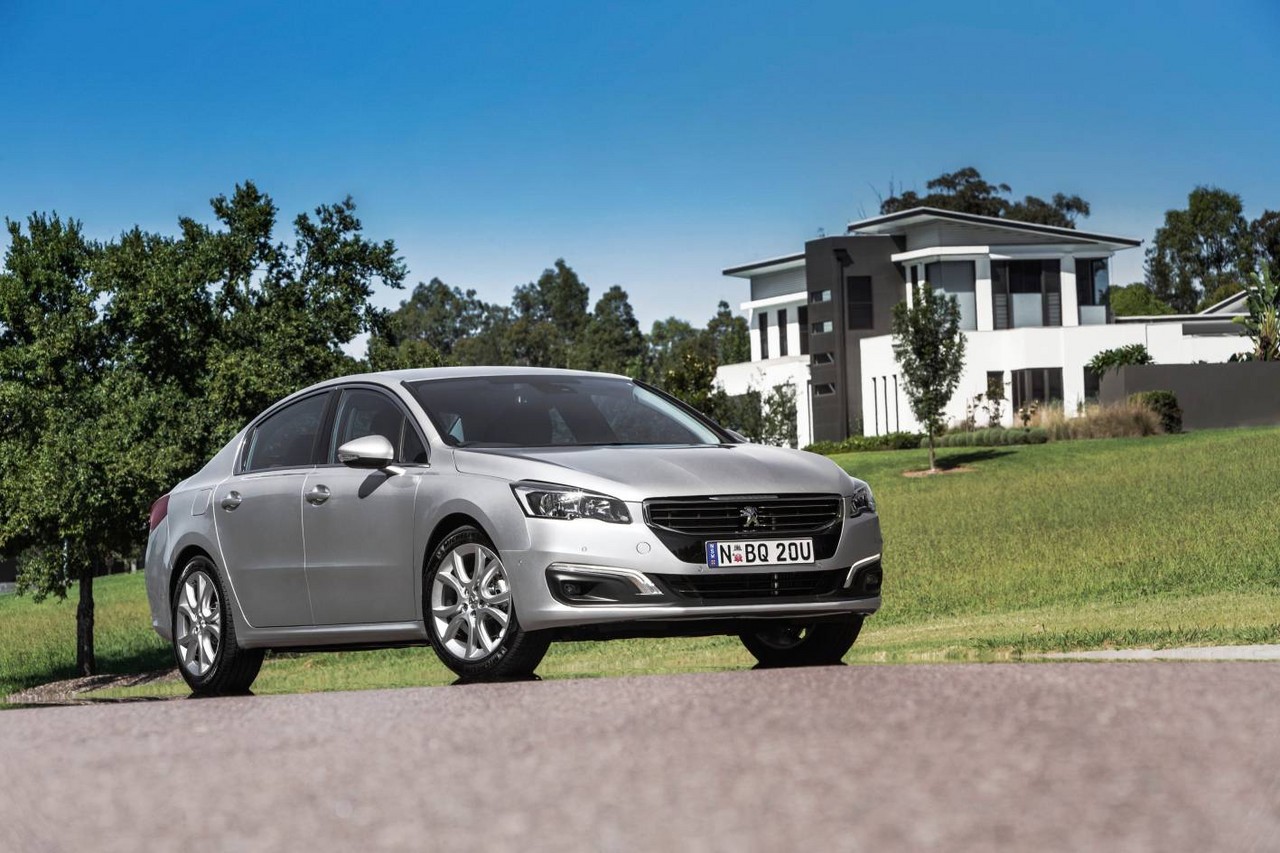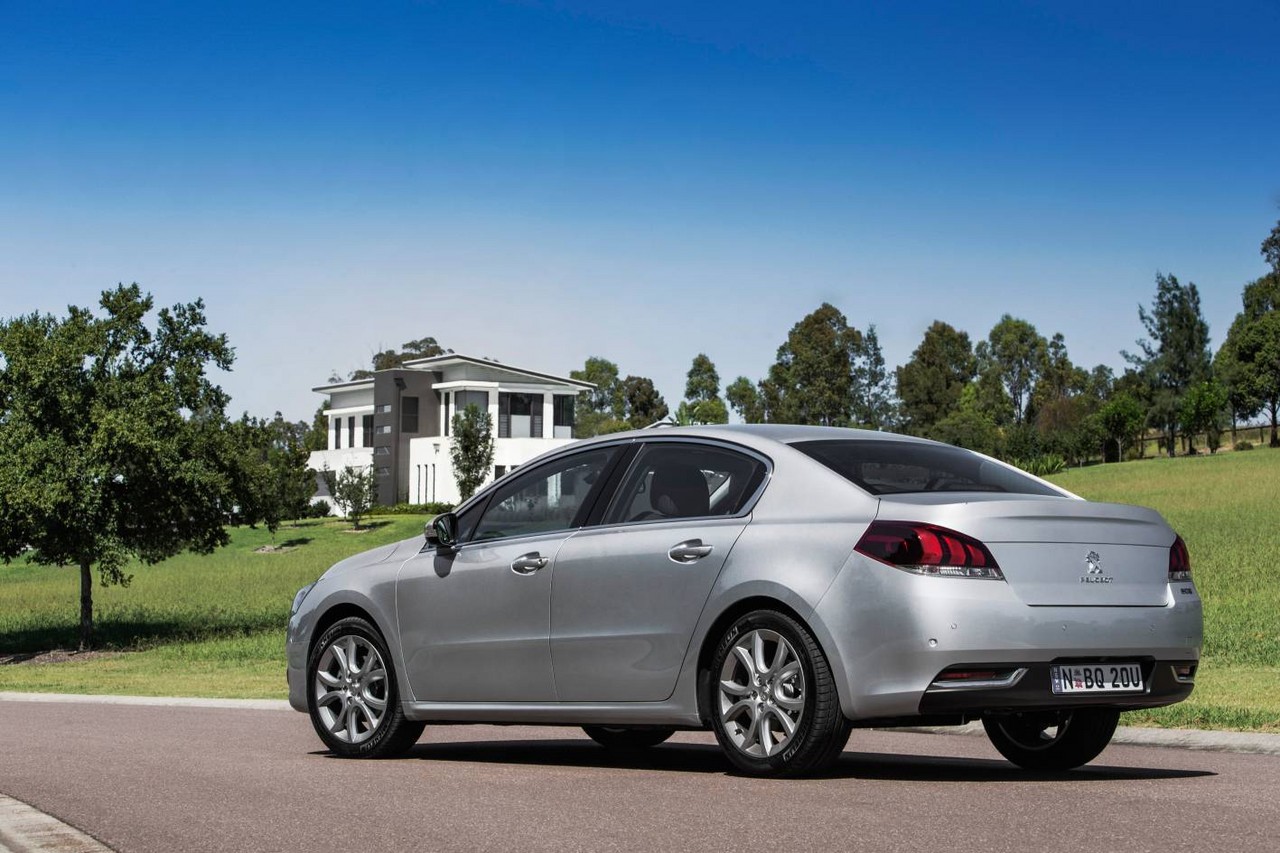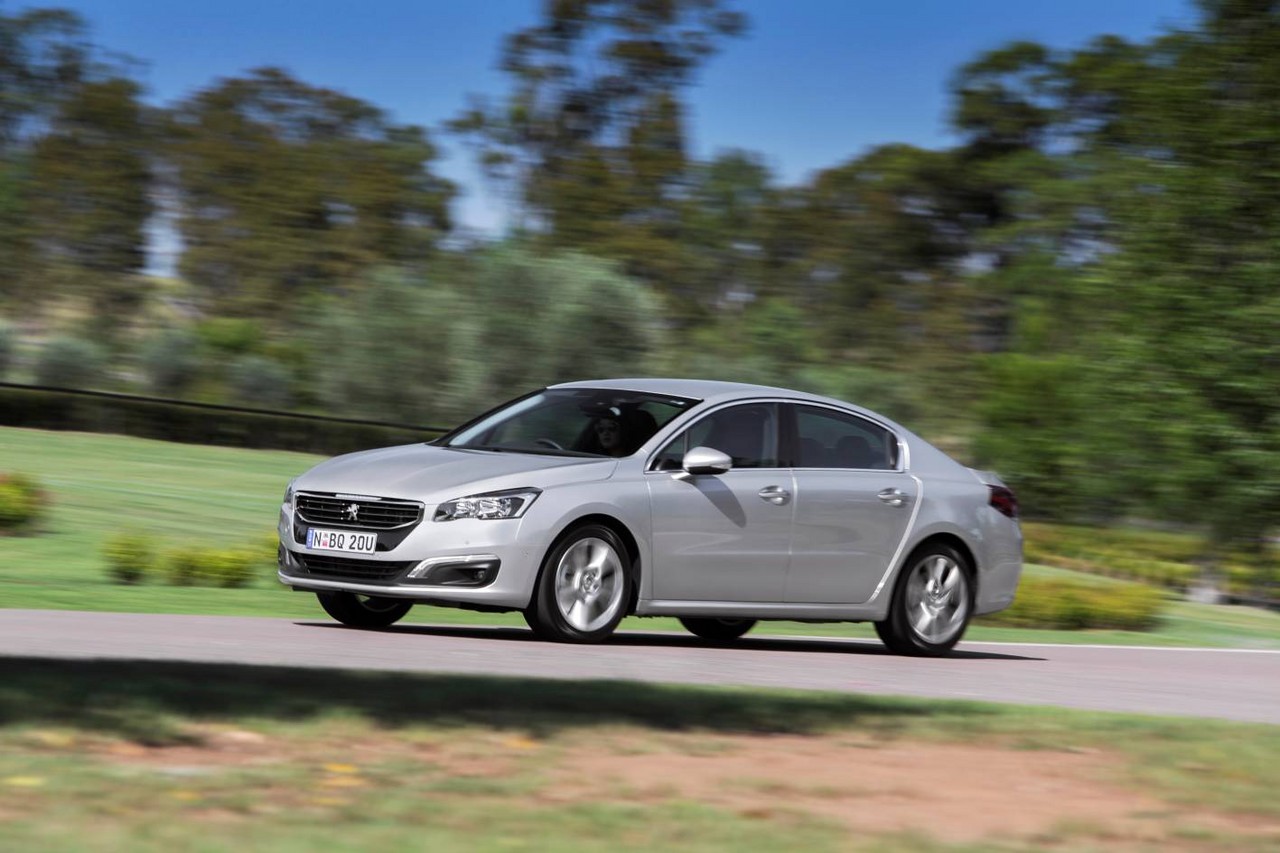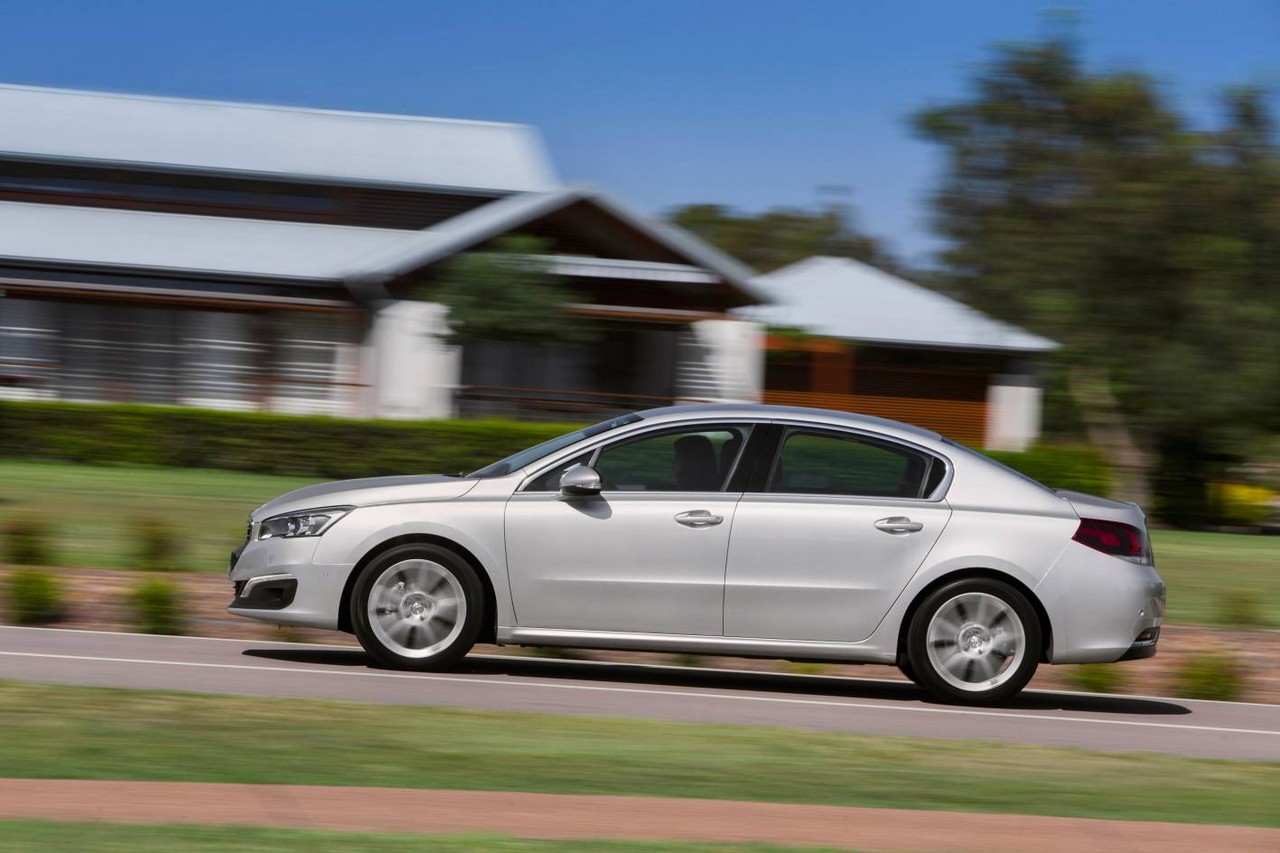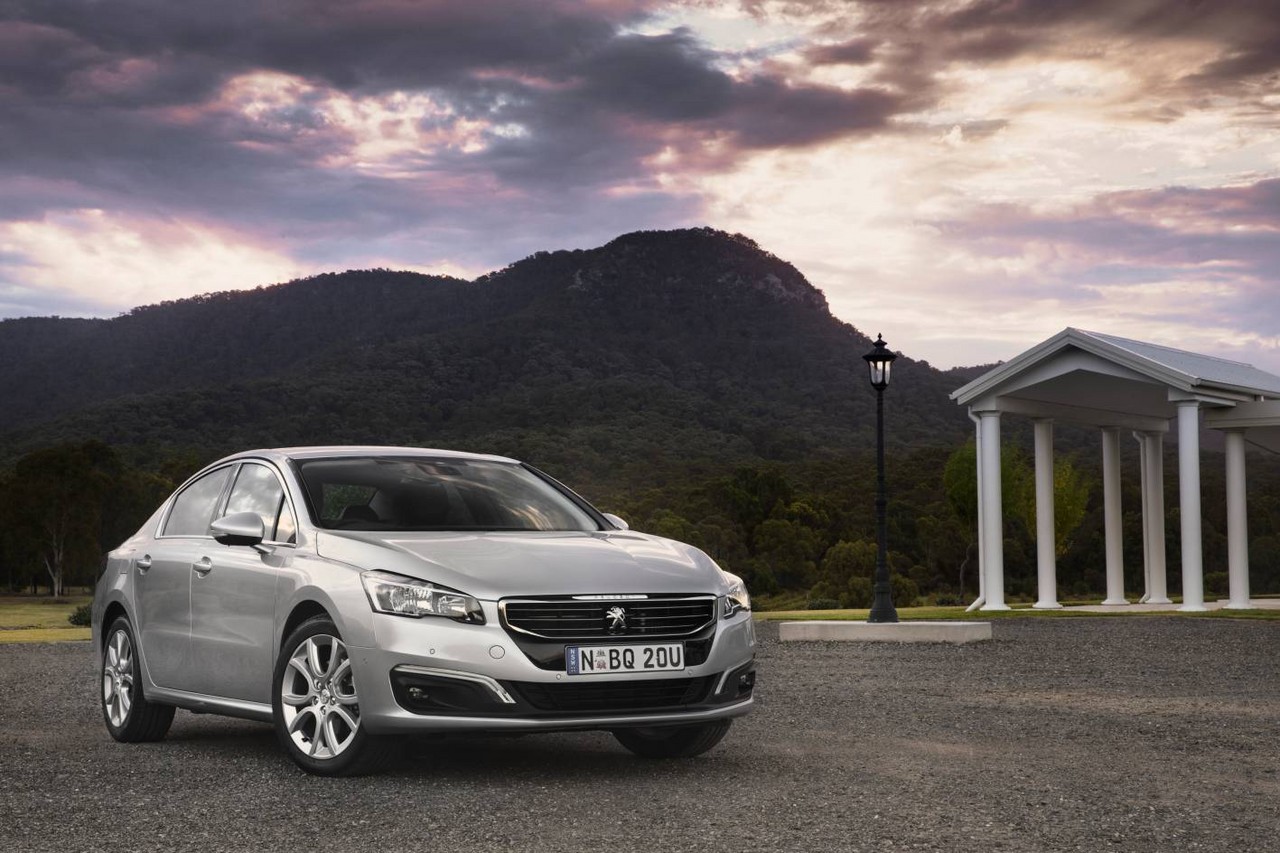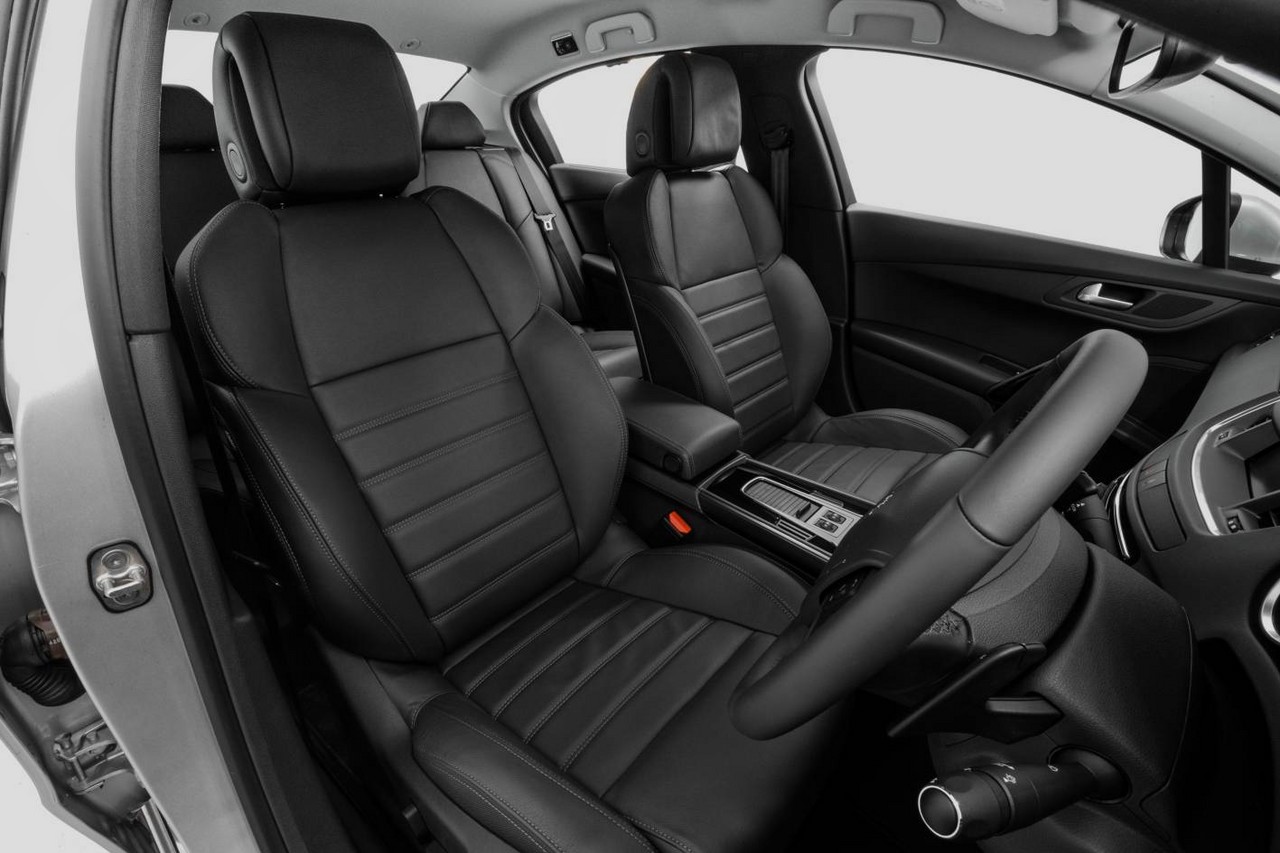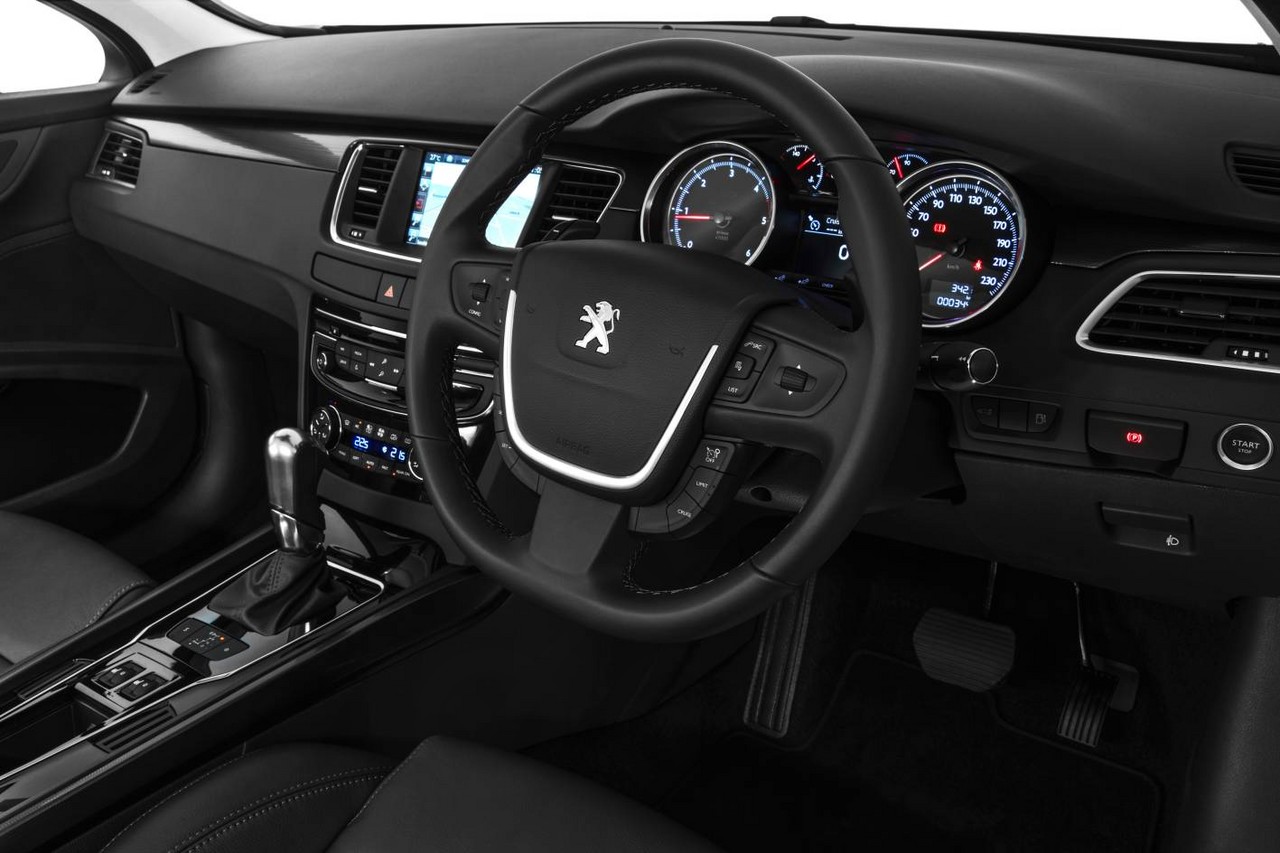
- Willing 1.6-litre turbocharged petrol engine
- Responsive 2.0- and 2.2-litre turbo-diesel engines
- Generally comfortable ride
- 508 GT has competent dynamics
- Quiet, well-insulated cabin
- Steering is well-weighted…
- … but lacks feel, especially just off centre
- Suspension struggles with bigger bumps
- For 508 GT, suspension lacks compliance
- For 1.6-litre turbo-diesel engine, vibration at idle
- Brake pedal lacks initial response
Review: Peugeot W2.I 508 (2011-14)
Overview
Released in July 2011, the Peugeot W2 Phase I (W2.I) 508 was available as a mid-size sedan or wagon. Manufactured in Rennes, France, the front-wheel drive 508 was offered with four different engines and in three variants: Active (sedan only), Allure (sedan and wagon) and Active (initially sedan only, with the wagon following in April 2012).
Engines: EP6DT, DV6, DW10 and DW12
Of the engines,
- The 1.6-litre EP6DT four-cylinder petrol engine had a twin scroll turbocharger, direct fuel injection, double overhead camshafts, four valves per cylinder, variable inlet valve timing and a compression ratio of 10.5:1;
- The 1.6-litre DV6 e-HDi four-cylinder diesel engine had a twin-scroll turbocharger, common-rail direct injection, double overhead camshafts, four valves per cylinder and a compression ratio of 16.0:1. This engine also featured a ‘Stop & Start’ function which enabled it to shut down when the vehicle was stationary to reduce fuel consumption;
- The 2.0-litre DW10 C HDi diesel engine had similar properties to the DV6 engine, but had a variable geometry turbocharger and omitted ‘Stop & Start’; and,
- The 2.2-litre DW12 C HDi four-cylinder diesel engine was distinguished by its lightweight titanium turbocharger impeller and piezo-electric injectors.
The 1.6 e-HDI engine was mated to Peugeot’s ‘EGC’ (semi-automatic) transmission with automatic and clutchless manual modes, though a conventional six-speed automatic transmission was standard for all other models.
| Body | Variant | Edition | Engine | Trans. | Peak power | Peak torque |
|---|---|---|---|---|---|---|
| Sedan | 1.6 HDi | Active | 1598 cc DV6C turbo-diesel I4 | 6sp semi-auto | 82 kW at 3600 rpm | 270 Nm at 1750 rpm |
| 1.6 Turbo | Active, Allure |
1598 cc EP6CDT turbo petrol I4 | 6sp auto | 115 kW at 6000 rpm | 240 Nm at 1400 rpm | |
| 2.0 HDi | Allure | 1997 cc DW10CTED4 turbo-diesel I4 | 6sp auto | 120 kW at 3750 rpm | 340 Nm at 2000 rpm | |
| 2.2 HDi | GT | 2179 cc DW12 turbo-diesel I4 | 6sp auto | 150 kW at 3500 rpm | 450 Nm at 2000 rpm | |
| Wagon | 1.6 Turbo | Allure | 1598 cc DV6C turbo-diesel I4 | 6sp auto | 115 kW at 6000 rpm | 240 Nm at 1400 rpm |
| 2.0 HDi | Allure | 1997 cc DW10CTED4 turbo-diesel I4 | 6sp auto | 120 kW at 3750 rpm | 340 Nm at 2000 rpm | |
| 2.2 HDi (2012-14) |
GT | 2179 cc DW12 turbo-diesel I4 | 6sp auto | 150 kW at 3500 rpm | 450 Nm at 2000 rpm |
Dimensions
Compared to the Peugeot 407 Sedan , the 508 sedan was 116 mm longer (at 4792 mm), 42 mm wider (1853 mm), 9 mm taller (1456 mm) and had a 92 mm longer wheelbase (2817 mm). Relative to the sedan, the 508 wagon was 21 mm longer (at 4813 mm) and 19 mm taller (1475 mm), though the other dimensions were unchanged. The 508 sedan had a drag coefficient of 0.25 Cd, while the 508 Touring was 0.25 Cd.
Suspension
While the Peugeot 508 Active and Allure variants were fitted with a MacPherson strut-type front suspension, the GT was fitted with an aluminium drop-link double-wishbone arrangement which sought to isolate suspension and steering forces for better handling and steering accuracy. All 508 models, however, had independent multi-link rear suspension, while electrohydraulic steering was also fitted as standard.
Safety equipment
Standard safety equipment for the Peugeot 508 included dual front airbags, front side airbags, full length curtain airbags (i.e. for front and rear occupants), ABS, electronic brake force distribution, brake assist, electronic stability control, cornering brake control, traction control, front seatbelts with pretensioners and load limiters and outer rear seatbelts with load limiters.
Brakes
The standard braking package for the W2 508 consisted of 304 mm by 28 mm vented front brake discs and 290 mm by 12 mm solid rear discs. The 2.2 HDi GT models, however, had 340 mm by 30 mm vented front brake discs.
Euro NCAP testing
In Euro NCAP testing , the Peugeot 508 Active – fitted with a 1.6-litre turbo-diesel engine – achieved a five star safety rating which included a 90 per cent adult occupant protection rating and an 87 per child occupant protection rating. In the frontal offset crash test, there was as slight risk of serious chest injury for the driver and a slight risk of serious leg injury for both front occupants. In the side impact test, there was also a slight risk of serious chest for the driver. Under ANCAP’s methodology , this testing resulted in an adult occupant protection rating of 35.1 out of 37.
Features: 508 Active, Allure and GT
Standard features for the 508 Active edition included 17-inch alloy wheels, an eight speaker Arkamys sound system with CD player, Bluetooth and USB connectivity, dual zone climate control air conditioning, power adjustable driver’s seat, cruise control and speed limiter, leather-wrapped multi-function steering wheel, front and rear fog lights, rear parking sensors, daytime running lights, automatic headlights, rain-sensing wipers, remote central locking, power windows and heated mirrors, a height and reach adjustable steering wheel, electrochrome rear view mirror, front map lights, 12 volt power outlet, trip computer and immobiliser. Inside, the 508 had a 60/40 split and folding rear seat; for wagon models, the rear seats could fold to form a flat loading floor.
The 508 Allure was further equipped with four-zone climate control air conditioning with rear controls, leather-trimmed seats, power adjustable front seats, front parking sensors, park assist (parking space measurement), proximity key with keyless start, rear seat side sun blinds, electric park brake, power folding mirrors and front footwell lighting.
The range-topping 508 GT featured 18-inch alloy wheels with two-tone black and silver rims, colour head-up display, directional bi-xenon headlights with washers, tyre pressure sensors and an alarm.
Brochures
Related links
Review: Peugeot W2.II 508 (2015-17)
Overview
Released in Australia in March 2015, the Peugeot W2 Phase II (W2.II) 508 introduced revised styling, additional features and an upgraded 1.6-litre turbocharged engine which complied with Euro 6 emissions standards.
Visually, the W2.II 508 could be identified by its new front guards, bonnet, more upright front grille with centre-mounted Peugeot lion, headlights and front bumpers with integrated daytime running lamps; sedans also had a redesigned rear bumper and LED tail-lights. As a result of the new bumpers, both the W2.II 508 sedan and wagon had 16 mm longer front overhangs, while the 508 sedan also had a 22 mm longer rear overhang.
Upgrades for the 1.6-litre turbocharged petrol included:
- A ‘Stop & Start’ function which could shut down the engine when the vehicle was stationary in traffic;
- A new turbocharger design;
- Increased fuel pressure from 120 bar to 200 bar; and,
- Reduced friction due to the adoption of Diamond Like Coating (DLC) for internal components and finer machining of camshaft bearings.
In September 2015, the 2.2-litre turbo-diesel for the 508 GT was replaced by Peugeot’s 2.0-litre ‘BlueHDi’ engine which complied with Euro 6 emissions standards. Over the combined ADR 81/02 test cycle, fuel consumption for the 508 GT sedan was 5.1 litres per 100 km.
| Body | Variant | Edition | Engine | Trans. | Peak power | Peak torque |
|---|---|---|---|---|---|---|
| Sedan | 1.6 Turbo | Active | 1598 cc EP6FDT turbo petrol I4 | 6sp auto | 121 kW at 6000 rpm | 240 Nm at 1400-4000 rpm |
| Sedan, wagon |
2.0 HDi | Allure | 1997 cc DW10CTED4 turbo-diesel I4 | 6sp auto | 120 kW at 3750 rpm | 340 Nm at 2000 rpm |
| 2.2 HDi | GT | 2179 cc DW12 turbo-diesel I4 | 6sp auto | 150 kW at 3500 rpm | 450 Nm at 2000 rpm | |
| 2.0 BlueHDi | GT | 1997 cc DW10CTED4 turbo-diesel I4 | 6sp auto | 133 kW at 3750 rpm | 400 Nm at 2000 rpm |
Safety equipment
Compared to its W2.I predecessor, standard safety equipment for the 508 Allure and GT editions was extended to include a blind spot monitoring system.
Features
Standard safety equipment for the 508 Active was extended to include a seven-inch touchscreen with satellite navigation and reversing camera, 8GB media storage, combination cloth and leather trim, LED front fog lights and daytime running lights, steering wheel gearshift paddles and a rear sunblind.
Relative to the Active, the 508 Allure was further equipped with 18-inch alloy wheels with 235/45 R18 tyres, four-zone climate control air conditioning, leather trim, power adjustable and heated front seats, front parking sensors, parallel parking space measurement, proximity key (i.e. keyless entry), push-button start, power folding door mirrors, electric parking brake, rear side sunblinds and front footwell lighting. Beyond this, the 508 Touring added a 12 volt power socket in the rear cargo area and a retractable cargo net that extended from the roof and to the rear seats.
Compared to the Allure, the 508 GT was distinguished by its 19-inch alloy wheels with 235/40 R19 tyres, Nappa leather trim, adaptive LED headlights, colour head-up display (HUD), driver’s seat memory settings and massage function, tyre pressure sensors and alarm system.
Related links
- Specifications: Peugeot W2.II 508 Sedan (March 2015)
- Specifications: Peugeot W2.II 508 Touring (March 2015)
- Press Kit: Peugeot W2.II 508 (March 2015)
- Wikipedia.org: Peugeot 508
